My lasting impression of our first week in Maine is of a density of people uncharacteristic of the state. The first shock to
the system was at
Sebago Lake State Park which could well be renamed the campground from hell. Admittedly it was still high season but
pitches here are crammed in within feet of each other resulting in a concentration of people more normally associated with the
inner cities and a noise level usually associated with a conurbation. It is difficult to know why people are drawn here in such
numbers; the lake’s nice enough and there are tiny strips of sand which are amusingly called beaches but other than the odd
playground and a few short trails there does not seem to be much here. It’s possible that out of season it’s a different story.
Sterling remembers cycling here from Rollinsford for an overnight stay and could not recall anything similar to our experience.
Of course he may simply have been exhausted after the ride and fallen asleep oblivious to the racket but I suspect he was just
here when the masses were not.

There are a number of routes leading to the campground but our first two attempts to get there were thwarted by a bridge with
a low weight rating and somewhat vague warning signs. This did not make us feel well disposed towards the bridge until we went
over to Songo Lock and found that the park did after all have two redeeming features; the lock itself and an associated hand
cranked bridge; the former common enough to us from Britain, the latter very unusual in either country and as it turned out,
the source of our earlier frustration. Constructed of a wrought iron frame and sidings but a bed fashioned from wood, it had
the six ton limit responsible for our driving up and down the back roads in our original attempts to reach the campground.
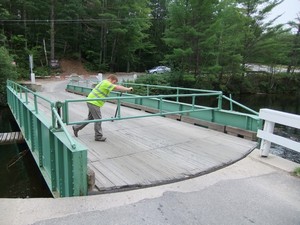 The structure of the bridge is interesting enough but its opening mechanism is the really nifty part. Out comes the bridge-keeper
from his tiny waterside shack, closes the barriers at either end of the bridge, picks up a long metal crank and placing it in a
socket starts walking round and round, slowly swinging the bridge through ninety degrees and thus opening the waterway for the
boats emerging from the lock.
The structure of the bridge is interesting enough but its opening mechanism is the really nifty part. Out comes the bridge-keeper
from his tiny waterside shack, closes the barriers at either end of the bridge, picks up a long metal crank and placing it in a
socket starts walking round and round, slowly swinging the bridge through ninety degrees and thus opening the waterway for the
boats emerging from the lock.
Leaving Sebago Lake for Freeport brings to mind the phrase out of the frying pan, into the fire. This town has become a huge shopping destination and the enormous car parks, packed to the gunwales, are merely a foretaste of the mayhem out on the pavements and high street, where trying to walk counter to the flow or cross the road is a hazardous undertaking. We are here to go to the flagship store of the northeast’s famous retailer, LL Bean. Their boasts of being open twenty four hours a day, three hundred and sixty five days a year are a true testament to this most consumer oriented town but leave me wondering about their expectation that their employees will work even when the majority of people in the country might expect some time off. We park up for the night and as the light fades, the car parks empty and the pavements become virtually deserted, the dedicated shoppers back at their hotels. The town feels much more appealing without the crowds and the picture the following morning is similarly quiet, as heavy rain keeps the bargain hunters at bay and makes the drive out of town an easy business.
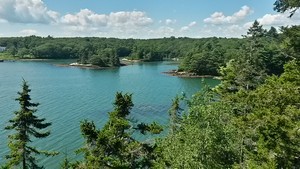 Some days later, whilst out on a short trail,
I get my first glimpse of what the Maine coast has to offer; the sun glinting off the deep blue water, small tree covered
islands, the solid rich colour of dense evergreens framing the coves, driftwood scoured and left bleaching in the sun. It
raises my hopes that our experience of the state so far is about to change but it turns out we have one more crowd scene to
play before we can truly make the transition.
Some days later, whilst out on a short trail,
I get my first glimpse of what the Maine coast has to offer; the sun glinting off the deep blue water, small tree covered
islands, the solid rich colour of dense evergreens framing the coves, driftwood scoured and left bleaching in the sun. It
raises my hopes that our experience of the state so far is about to change but it turns out we have one more crowd scene to
play before we can truly make the transition.
For the first time in many weeks we decide to have a hook-up and head for a commercial resort at Lake Pemaquid. We rarely stay anywhere like this and so walk the loops, checking out the attractions such as the swimming pool, store, snack bar, miniature train and aqua cycles, before returning to our site confident that we will be ready to leave in the morning. As night falls a system of perimeter lights suddenly bursts into life emitting a glaring light along the boundary fence; whether to keep others out or campers in is unclear but it confirms our decision to move on.
 Maps of one sort or another are a crucial part of our daily lives whether it's Google, our old American Map road atlas or
specific hiking maps. When we full-timed first time round we relied on Delorme software for much of our topographical mapping
needs, as well as for navigation out on the roads, but things have moved on since then and while we rarely use Delorme nowadays
it still has a soft spot in our hearts. Their headquarters outside Freeport have a visitor centre and shop and given our love of
maps we had to go and visit. In a huge glass sided foyer is the world’s largest rotating, revolving globe, named aptly enough;
Eartha. It is truly impressive and mesmeric, our photographs failing to
do it justice. Eartha’s scale renders the globe’s image at approximately one inch to every sixteen miles on the ground. The level
of detail is a delight and along with some very familiar looking areas on the earth’s surface, it is the first time that I have
noticed a ring shaped lake in north eastern Canada. It turns out to be Lake Manicouagan in Quebec.The lake lies in a meteor
impact crater and with a seventy kilometer diameter is large enough not only to be clearly visible on Eartha but also to be
seen from space.
Maps of one sort or another are a crucial part of our daily lives whether it's Google, our old American Map road atlas or
specific hiking maps. When we full-timed first time round we relied on Delorme software for much of our topographical mapping
needs, as well as for navigation out on the roads, but things have moved on since then and while we rarely use Delorme nowadays
it still has a soft spot in our hearts. Their headquarters outside Freeport have a visitor centre and shop and given our love of
maps we had to go and visit. In a huge glass sided foyer is the world’s largest rotating, revolving globe, named aptly enough;
Eartha. It is truly impressive and mesmeric, our photographs failing to
do it justice. Eartha’s scale renders the globe’s image at approximately one inch to every sixteen miles on the ground. The level
of detail is a delight and along with some very familiar looking areas on the earth’s surface, it is the first time that I have
noticed a ring shaped lake in north eastern Canada. It turns out to be Lake Manicouagan in Quebec.The lake lies in a meteor
impact crater and with a seventy kilometer diameter is large enough not only to be clearly visible on Eartha but also to be
seen from space.
We add the crater to a list of places we want to visit in Canada and continue heading northeast towards the border, a few stops scheduled on the way. Deer Isle is our first destination and we take the coast road, driving through an atmospheric mist, thick in places, swirling wisps elsewhere. The small coastal villages are the mix of real life and tourism characteristic of the area. Lincolnville where we stop for chowder is no exception with its ferry terminal, mixed fleet of lobster and pleasure boats, numerous craft shops and eateries. On this cool day the beach is virtually deserted except for a few diehards although even they have forsaken their swimming costumes.
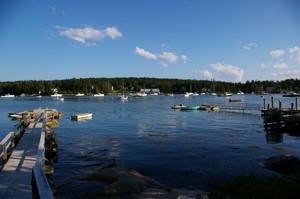 Deer Isle is comprised of Deer Island to the north and Bear to the south. We’re heading for the latter and a few days of work
basing ourselves at a quirky campground that is in walking distance of Burnt Cove.
Sterling is preoccupied with satellite dish problems and embarks on a very interesting experiment to test his hypothesis on the
cause of our difficulties. The first part involves paying the two dollars for a water hook-up. For those in the know, this will
immediately give some indication of the unusual nature of this place; they offer an a la carte menu of hook-ups from which you
can choose on a daily basis, without having to move site. Anyway, back to the test. The theory is that a particular part of the
dish apparatus is overheating causing the connection to drop. The test involves waiting for the temperature to rise sufficiently
to knock us offline and Sterling then attempting to cool the offending part by aiming a stream of cold water up at the roof while
I watch the indicator lights on the modem inside. Unfortunately the test seems conclusive indicating the need to replace a fairly
expensive piece of equipment. Such are the costs of needing good connectivity to earn a living.
Deer Isle is comprised of Deer Island to the north and Bear to the south. We’re heading for the latter and a few days of work
basing ourselves at a quirky campground that is in walking distance of Burnt Cove.
Sterling is preoccupied with satellite dish problems and embarks on a very interesting experiment to test his hypothesis on the
cause of our difficulties. The first part involves paying the two dollars for a water hook-up. For those in the know, this will
immediately give some indication of the unusual nature of this place; they offer an a la carte menu of hook-ups from which you
can choose on a daily basis, without having to move site. Anyway, back to the test. The theory is that a particular part of the
dish apparatus is overheating causing the connection to drop. The test involves waiting for the temperature to rise sufficiently
to knock us offline and Sterling then attempting to cool the offending part by aiming a stream of cold water up at the roof while
I watch the indicator lights on the modem inside. Unfortunately the test seems conclusive indicating the need to replace a fairly
expensive piece of equipment. Such are the costs of needing good connectivity to earn a living.
Stonington is a small village on the south coast of Bear Island; off the tourist route, its streets are narrow, running up the hill perpendicular to the water, its parking limited. We leave the rig at the top and walk down for that most iconic of Maine lunches; a lobster roll. There’s a small ice cream and lobster shack opposite the end of the wharf and we sit and eat the most delicious snack involving tender chunks of crustacean followed by ice cream. The harbour has a public ramp and consequently there are a few pleasure boats moored along with the more numerous lobster boats in the small harbour. The land end of the wharf is dominated by a sculpture of a stone cutter commemorating the granite for which the place was once famous. The quarries are long gone but the hundreds of lobster pots to be seen everywhere serve as evidence of its current primary occupation.
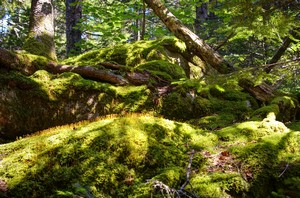 Barrred Island Preserve, just off Goose Cove on Bear Island, offers
the opportunity to experience a perfect snapshot of Maine. A short trail wends its way through an impressively mossy woodland,
the understory a wonderful tumble of boulders, roots, and downed trees all clothed in this soft, lush, emerald green covering,
highlighted in patches by sunshine penetrating the upper canopy. Woodland rarely moves me to this extent but this is a truly
beautiful place and the slow pace needed to appreciate it fully makes this short walk a lengthy business. From a viewpoint on
a rocky clearing, the view stretches along the coast and out over the waters of Penobscot Bay, the glimmering surface dotted
with islands of various shapes and sizes, the closer defined in clear detail, the more distant, mere silhouettes. The path
emerges on a sandbar, both its edges creating perfect crescents along the water, the grains and rock piling in the middle to
create a rounded ridge, bridging the gap to Barred Island. Its low tide and so possible to cross over but signs warn that the
connection disappears under five feet of water at high tide.
Barrred Island Preserve, just off Goose Cove on Bear Island, offers
the opportunity to experience a perfect snapshot of Maine. A short trail wends its way through an impressively mossy woodland,
the understory a wonderful tumble of boulders, roots, and downed trees all clothed in this soft, lush, emerald green covering,
highlighted in patches by sunshine penetrating the upper canopy. Woodland rarely moves me to this extent but this is a truly
beautiful place and the slow pace needed to appreciate it fully makes this short walk a lengthy business. From a viewpoint on
a rocky clearing, the view stretches along the coast and out over the waters of Penobscot Bay, the glimmering surface dotted
with islands of various shapes and sizes, the closer defined in clear detail, the more distant, mere silhouettes. The path
emerges on a sandbar, both its edges creating perfect crescents along the water, the grains and rock piling in the middle to
create a rounded ridge, bridging the gap to Barred Island. Its low tide and so possible to cross over but signs warn that the
connection disappears under five feet of water at high tide.
 The island is a small rocky outcrop, the bare strata around its edges kept clear by the salt water, its slightly higher ground
allowing brine and wind-hardy plants, along with the evergreens, to eke out an existence. We clamber around the rocks, walk on
the beach, listen to the waves wash up the gentle slope of the sandbar, look out over the water to the more distant islands, and
simply sit in the warm sun, gazing at this wonderful setting, absorbing its numerous delights. It is a hard place to leave.
The island is a small rocky outcrop, the bare strata around its edges kept clear by the salt water, its slightly higher ground
allowing brine and wind-hardy plants, along with the evergreens, to eke out an existence. We clamber around the rocks, walk on
the beach, listen to the waves wash up the gentle slope of the sandbar, look out over the water to the more distant islands, and
simply sit in the warm sun, gazing at this wonderful setting, absorbing its numerous delights. It is a hard place to leave.
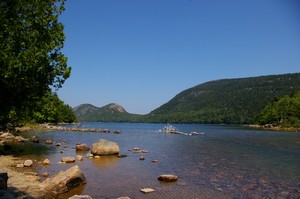 Luckily we’re heading for Acadia National Park with its rounded mountains,
lakes and spectacular coast. The park has a system of carriage roads originally built, as the name suggests, for the four wheeled
variety of transport pulled by a horse. Now a days they are largely used by cyclists although the horse camp is still busy and
there are organised carriage rides for those who come without their own steed. Sterling used to ride these paths frequently when
living in Maine and we have one afternoon cycling together. It leaves Sterling champing at the bit, yearning for speed and
distance and so a few days later we part company, me to hike around Jordan Pond and up Cedar Swamp Mountain, he to ride like a
wild thing over forty miles of trail; a satisfactory arrangement for both of us.
Luckily we’re heading for Acadia National Park with its rounded mountains,
lakes and spectacular coast. The park has a system of carriage roads originally built, as the name suggests, for the four wheeled
variety of transport pulled by a horse. Now a days they are largely used by cyclists although the horse camp is still busy and
there are organised carriage rides for those who come without their own steed. Sterling used to ride these paths frequently when
living in Maine and we have one afternoon cycling together. It leaves Sterling champing at the bit, yearning for speed and
distance and so a few days later we part company, me to hike around Jordan Pond and up Cedar Swamp Mountain, he to ride like a
wild thing over forty miles of trail; a satisfactory arrangement for both of us.
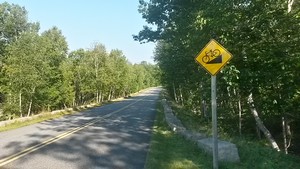
We have a limited time here and much of the rest of it is spent out on the trails and trying to cram a little work in before
setting off. Our first afternoon only gives us a couple of hours, so we set off for the Ocean Path and while it’s very busy in
places due to its accessibility from the road, the views along the coast make it worthwhile.
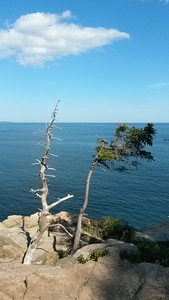
Options for both walking and cycling are improved by the free system of buses that run in the park. It’s possible to hike or bike from the campground and catch a bus back from somewhere else on the peninsula or conversely catch the bus out and come back under our own steam. We leave the rig parked where it is, make good use of the free transportation and get to experience many of the highlights of the park.
The trail from the campground up to Cadillac Mountain starts off in the woods and climbs steadily, the trees progressively thinning and shrinking in height, initial glimpses of the water becoming wide open panoramas as the path crosses expanses of bare bedrock, the cracks filled with low alpine plants. There are few people out here and that makes the shock at the top all the greater. There’s road access to the three hundred and sixty degree views up here and the masses have come in their hundreds. A quick stop in the shop for the obligatory magnet and an ice cream and we’re on our way back down, savouring the cold treat as we sit on a handy rock ledge looking out across the bay, the waters studded with the islands that are ubiquitous off this part of the Maine coast.
 Our other joint hike takes us up Bald Peak and Parkman Mountain. The ascending trail is more like a low level scramble in places
and quite the challenge but again the views from the top make it worthwhile and the summit of Parkman is an ideal lunch spot.
Hikes of any length always involve the making of statutory sandwiches; cheese, tomato and mayonnaise on brown bread or occasionally a
roll. In most regards we are quite adventurous but when it comes to butties to take on a walk, there are clear rules. I’ve been
an advocate of said statutory sandwich for many years and while I have dabbled in seemingly more exciting fillings I have always
returned to this favourite. It is a sandwich perfect for putting in the bottom of a rucksack, to be removed some hours later,
slightly squashed and devoured with absolute enthusiasm. In Massachusetts a few weeks ago we stayed in a town whose name required
the law enforcement officers to drive round in a car labeled Sandwich Police. While others may have been worried about being
pulled over, we were confident that our lunchtime repast would meet with approval.
Our other joint hike takes us up Bald Peak and Parkman Mountain. The ascending trail is more like a low level scramble in places
and quite the challenge but again the views from the top make it worthwhile and the summit of Parkman is an ideal lunch spot.
Hikes of any length always involve the making of statutory sandwiches; cheese, tomato and mayonnaise on brown bread or occasionally a
roll. In most regards we are quite adventurous but when it comes to butties to take on a walk, there are clear rules. I’ve been
an advocate of said statutory sandwich for many years and while I have dabbled in seemingly more exciting fillings I have always
returned to this favourite. It is a sandwich perfect for putting in the bottom of a rucksack, to be removed some hours later,
slightly squashed and devoured with absolute enthusiasm. In Massachusetts a few weeks ago we stayed in a town whose name required
the law enforcement officers to drive round in a car labeled Sandwich Police. While others may have been worried about being
pulled over, we were confident that our lunchtime repast would meet with approval.